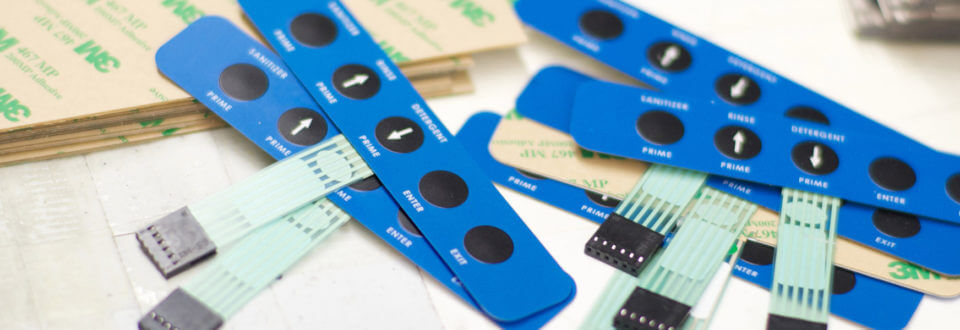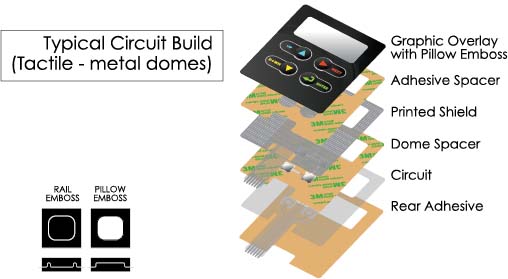Recognizing Membrane Layer Switches: The Trick to Long Lasting and Trusted Controls
Membrane switches over represent a vital aspect of contemporary user interface layout, mixing functionality with strength in various applications. These functional components not just help with individual interaction yet are likewise engineered to endure the rigors of demanding environments, from clinical devices to industrial machinery. Understanding their building and construction, operation, and the myriad advantages they provide is vital for designers and developers alike. As we check out the complexities of membrane switches, it comes to be clear that their function in boosting control systems is both extensive and complicated, elevating concerns about just how ideal to leverage their capabilities in future advancements.
What Are Membrane Switches?
Membrane buttons are a sophisticated remedy in the world of interface modern technology, combining functionality and style flawlessly. These devices act as an interface in between customers and electronic systems, incorporating several components right into a compact layout. Commonly built from adaptable, thin layers of materials, membrane buttons are developed to react to touch, allowing users to engage with machinery and electronic devices successfully.
The key elements of a membrane layer switch consist of a published circuit layer, visuals overlay, and a spacer layer that protects against unexpected activation. The visuals overlay can be personalized to show brand name identification or individual preferences, improving aesthetic appeals while making sure functionality. Membrane layer buttons are commonly made use of in different applications, including medical devices, consumer electronic devices, and commercial equipment, owing to their sturdiness and resistance to ecological variables such as moisture and dirt.
Among the key advantages of membrane layer switches is their ability to withstand damage, making them perfect for high-traffic environments. In addition, they are light-weight and call for marginal room, permitting ingenious designs in item growth. Generally, membrane switches represent a functional and efficient option for contemporary digital user interfaces, weding technology with user-centric style principles.

Just How Membrane Layer Switches Job
The procedure of membrane changes depend upon a simple yet reliable mechanism that translates individual input into digital signals. These switches contain multiple layers, typically consisting of a graphic overlay, a spacer layer, and a circuit layer. When a user presses the switch, the top layer warps, permitting a conductive aspect in the circuit layer to reach a matching conductive pad on the bottom of the visuals overlay. This get in touch with shuts the circuit and sends a digital signal to the gadget, showing that the switch has actually been triggered.
The style of membrane layer buttons can differ, but they often include domes or tactile components to give responses to the user, enhancing the general experience. The products made use of in membrane layer buttons, such as polyester or polycarbonate, contribute to their durability and resistance to environmental variables, consisting of moisture try this web-site and dirt. In addition, the printed circuits are generally encapsulated, which safeguards them from deterioration with time.

Advantages of Membrane Switches
One of the key benefits of membrane layer buttons is their versatility in layout, enabling them to be personalized to meet specific customer needs and visual demands. This versatility reaches various industries, where different forms, sizes, and shades can be employed to enhance individual interaction and aesthetic appeal.
Furthermore, membrane layer buttons are understood for their sturdiness. Built from robust products, they are resistant to dirt, wetness, and physical wear, which significantly expands their lifespan contrasted to traditional mechanical switches. This toughness makes them particularly appropriate for high-traffic settings and applications needing longevity.

In addition, membrane switches provide a structured account, resulting in a thinner layout that can be integrated right into different gadgets without adding bulk. This function not only enhances the aesthetic allure however additionally contributes to an extra ergonomic product layout.

Applications of Membrane Switches
Versatile and straightforward, membrane layer buttons find applications across a vast variety of sectors, including medical devices, customer electronic devices, and commercial equipment. In the clinical area, these buttons are indispensable to gadgets such as analysis equipment, client monitoring systems, and mixture pumps, where reliability and ease of cleaning are vital. Their ability to withstand rough settings and maintain functionality makes them optimal for such applications.
In customer electronics, membrane layer switches are utilized in items like microwaves, washing equipments, and push-button controls - membrane switch. Their sleek style allows for instinctive customer interfaces, enhancing the overall customer experience while providing resilience and resistance to tear and put on
Industrial equipment additionally benefits from membrane layer buttons, specifically in control panels for machinery and automation systems. These buttons supply defense against dust and dampness, guaranteeing constant efficiency in difficult environments. Their personalized features allow suppliers to customize them to specific operational needs, boosting effectiveness and capability.
Selecting the Right Membrane Layer Switch Over
When picking a membrane button, it is crucial to take into consideration various elements that affect efficiency and suitability for certain applications. The key considerations consist of ecological conditions, tactile comments, resilience, and style specifications.
First, evaluate the operating setting; switches exposed to wetness, chemicals, or severe temperature levels require particular materials to make certain durability and functionality. Next, examine the need for tactile responses. Depending upon individual interaction, some Continued applications might gain from a tactile response to confirm activation, while others might like a non-tactile layout for visual reasons.
Sturdiness is an additional navigate to this website vital variable; membrane layer switches ought to be created to hold up against constant usage, impacts, and abrasion. Make certain the chosen switch can withstand the anticipated lifecycle, especially in high-usage scenarios.
Verdict
To conclude, membrane switches function as essential parts in the layout of dependable and durable control systems across numerous industries. Their portable layout, integrated with robust construction and adjustable features, improves user interaction while ensuring longevity popular settings. The adaptability of membrane switches enables for customized options that meet details operational requirements, reinforcing their value in contemporary technology. membrane switch. As sectors remain to advance, the value of incorporating effective membrane switch services can not be overemphasized.
Membrane layer changes stand for a vital element of modern user interface layout, blending functionality with resilience in numerous applications.Membrane layer switches are a sophisticated remedy in the world of customer interface modern technology, combining capability and design perfectly. Usually constructed from versatile, thin layers of products, membrane switches are developed to react to touch, enabling users to interact with equipment and electronic devices successfully.
The style of membrane layer buttons can vary, however they usually incorporate domes or tactile aspects to offer responses to the user, enhancing the general experience.In final thought, membrane switches offer as essential components in the design of resilient and trustworthy control systems throughout various sectors.